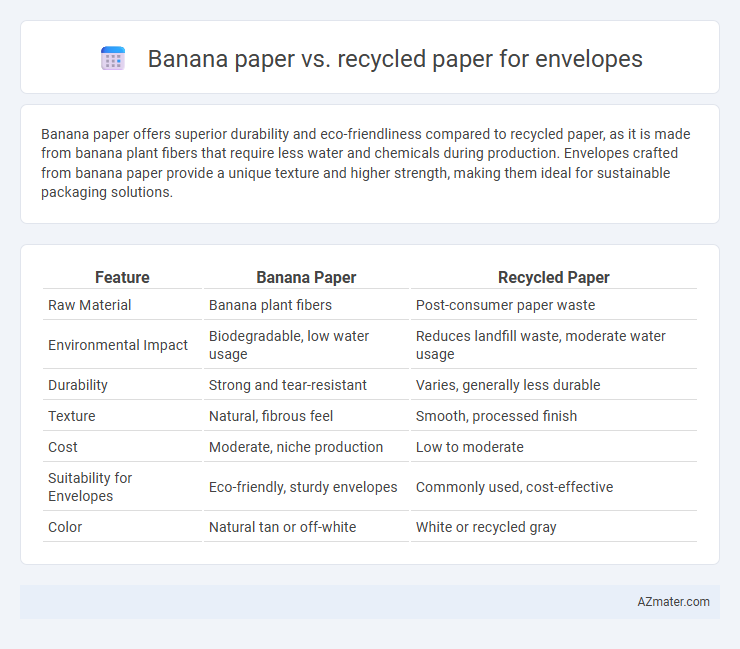Banana paper offers superior durability and eco-friendliness compared to recycled paper, as it is made from banana plant fibers that require less water and chemicals during production. Envelopes crafted from banana paper provide a unique texture and higher strength, making them ideal for sustainable packaging solutions.
Table of Comparison
| Feature | Banana Paper | Recycled Paper |
|---|---|---|
| Raw Material | Banana plant fibers | Post-consumer paper waste |
| Environmental Impact | Biodegradable, low water usage | Reduces landfill waste, moderate water usage |
| Durability | Strong and tear-resistant | Varies, generally less durable |
| Texture | Natural, fibrous feel | Smooth, processed finish |
| Cost | Moderate, niche production | Low to moderate |
| Suitability for Envelopes | Eco-friendly, sturdy envelopes | Commonly used, cost-effective |
| Color | Natural tan or off-white | White or recycled gray |
Introduction: The Need for Sustainable Envelope Solutions
Banana paper offers a sustainable alternative to traditional recycled paper for envelopes, utilizing fibers from banana plant waste that reduce deforestation and agricultural byproduct waste. Recycled paper envelopes contribute to waste reduction by repurposing post-consumer materials, lowering energy consumption compared to virgin paper production. Choosing banana paper or recycled paper envelopes supports eco-friendly packaging solutions that minimize environmental impact and promote circular economy principles.
What is Banana Paper?
Banana paper is an eco-friendly material made from the fibers of banana plants, primarily the pseudostem, which is typically discarded as agricultural waste. Unlike recycled paper that reuses post-consumer or post-industrial wood fiber, banana paper leverages a renewable resource, reducing deforestation and chemical use in production. This natural fiber composition results in a durable, textured envelope option with a lower carbon footprint compared to conventional recycled paper.
What is Recycled Paper?
Recycled paper is made from post-consumer waste materials, including used paper products that are collected, processed, and reformed into new paper. It reduces the need for virgin wood pulp, saving trees and decreasing energy consumption during production. This eco-friendly option supports sustainable practices by minimizing landfill waste and lowering carbon emissions associated with paper manufacturing.
Environmental Impact: Banana Paper vs Recycled Paper
Banana paper offers a sustainable alternative to recycled paper by utilizing agricultural waste from banana plants, significantly reducing deforestation and landfill waste. Unlike conventional recycled paper, which depends on the repurposing of previously used fibers, banana paper production emits lower carbon footprints due to minimal chemical processing. Choosing banana paper envelopes supports circular economy principles by promoting biodegradable and renewable materials with reduced environmental impact compared to traditional recycled options.
Manufacturing Process Comparison
Banana paper manufacturing involves extracting fibers from banana plant stems, which are cleaned, boiled, and mechanically processed into pulp without harsh chemicals, resulting in an eco-friendly production method. Recycled paper for envelopes is produced by collecting post-consumer paper waste, removing inks and contaminants through deinking, and re-pulping, which requires energy-intensive processes and chemical treatments to restore fiber quality. The banana paper process reduces dependency on wood pulp and lowers water usage, while recycled paper relies heavily on existing paper streams and involves complex processing to maintain durability and appearance.
Durability and Quality of Banana and Recycled Papers
Banana paper offers superior durability compared to recycled paper due to its strong natural fibers, making it more resistant to tearing and wear for envelope production. The quality of banana paper is often smoother and maintains a unique texture, enhancing the tactile experience and aesthetic appeal of envelopes. In contrast, recycled paper tends to have a rougher texture and lower tensile strength, which can compromise the envelope's longevity and overall presentation.
Cost Analysis: Banana Paper vs Recycled Paper Envelopes
Banana paper envelopes often cost more than recycled paper alternatives due to the specialized manufacturing process involving natural fibers from banana plants, which enhances durability and eco-friendliness but increases production expenses. Recycled paper envelopes generally offer a more affordable option, benefiting from widespread availability and established recycling infrastructure that reduces raw material costs. Businesses seeking sustainable yet economical packaging frequently weigh the premium of banana paper against the budget-friendly and environmentally conscious benefits of recycled paper.
Aesthetic and Design Differences
Banana paper envelopes exhibit a unique texture with natural fiber patterns and a subtle, warm beige tone that enhances rustic and eco-friendly designs, offering a tactile, organic appeal. Recycled paper envelopes, typically smoother with a more uniform appearance and neutral grayish or off-white shades, provide a clean, understated look that suits minimalist and modern aesthetics. The choice between banana paper and recycled paper envelopes directly impacts visual interest and branding, with banana paper emphasizing artisanal craftsmanship and recycled paper highlighting sustainability through polished simplicity.
Consumer and Business Perspectives
Banana paper offers a sustainable alternative to traditional recycled paper, appealing to eco-conscious consumers and businesses seeking innovative green solutions for envelopes. It is made from banana plant waste, reducing deforestation and chemical use compared to standard recycled paper, which primarily reprocesses old paper fibers. Businesses benefit from banana paper's durability and unique texture, enhancing brand image and meeting increasing demand for environmentally responsible packaging.
Future Trends in Eco-Friendly Envelope Materials
Banana paper, derived from agricultural waste fibers, offers superior biodegradability and strength compared to traditional recycled paper, driving innovation in sustainable envelope materials. Emerging trends show increased adoption of banana fiber envelopes due to their lower carbon footprint and enhanced durability, supporting circular economy principles. Investment in scalable production technologies and integration with eco-friendly inks is expected to accelerate the shift towards banana paper in the envelope manufacturing industry.

Infographic: Banana paper vs Recycled paper for Envelope
 azmater.com
azmater.com